Fighter aircraft of Taiwan
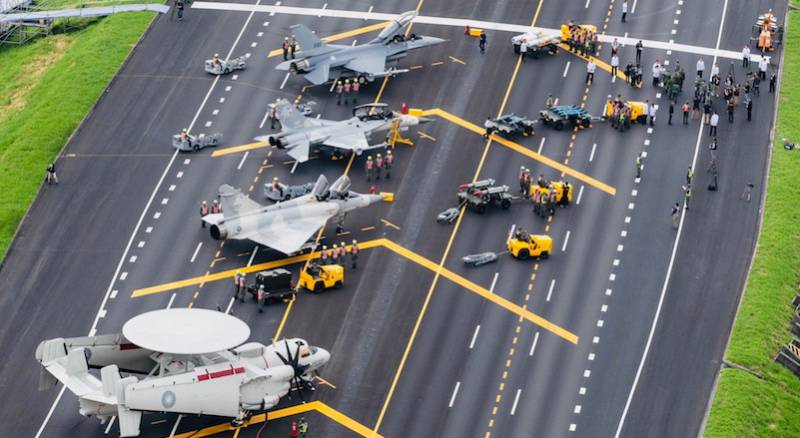
After the flight of the leadership and part of the Kuomintang troops to the island of Taiwan, the Republic of China Air Force (ROCAF) was based on American-made aircraft. In the 1950s-1980s, jet fighters were in service: the F-84 Thunderjet, F-86 Saber, F-100 Super Saber, F-104 Starfighter, F-5A / B Freedom Fighter and F-5E / F Tiger II. In the mid-1990s, F-16A / B Fighting Falcon fighters were purchased in the USA, and Mirage 2000-5 in France. In addition, the F-CK-1 Ching-Kuo fighter was created and mass-produced in Taiwan.
As of 2022, the ROCAF had 518 aircraft, of which 289 were fighters. For an island nation with an area of 36 km², this number of combat aviation fleet is very solid.
Much of the structure and organization of the ROCAF follows the American pattern, with fighter squadrons organized into aviation groups from which tactical aviation wings are formed. In 2005, most of the squadrons were disbanded, and the aviation groups became almost the same composition as the squadrons.
At present, the combat units of the Taiwan Air Force include: six wings of tactical combat aircraft (fighters), a transport and anti-submarine wing, a tactical control wing, a communications and air traffic control wing, a weather forecasting wing, and an air defense ground force command, which includes 5 brigades and 16 anti-aircraft artillery and missile divisions.
ROCAF aviation equipment is constantly located at nine large airfields, where at least 300 reinforced concrete hangars have been built.
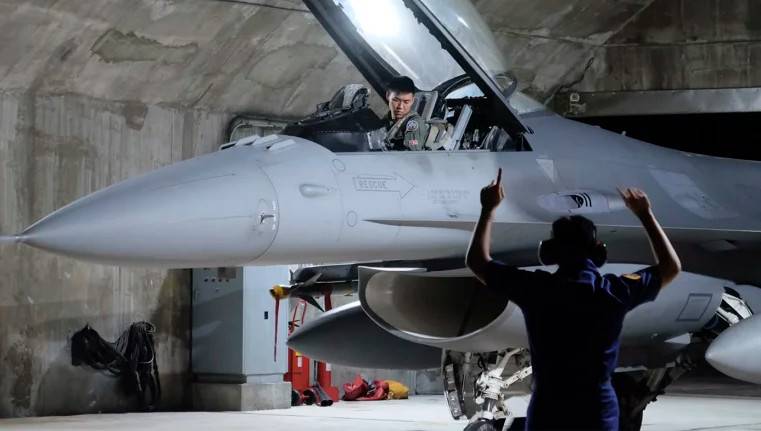
Taiwanese F-16A fighter in a reinforced concrete hangar
At least three Taiwanese air bases have highly secure underground shelters that can accommodate about half of the entire existing fighter fleet. The use of reserve runways and specially equipped sections of highways with tunnels is envisaged.
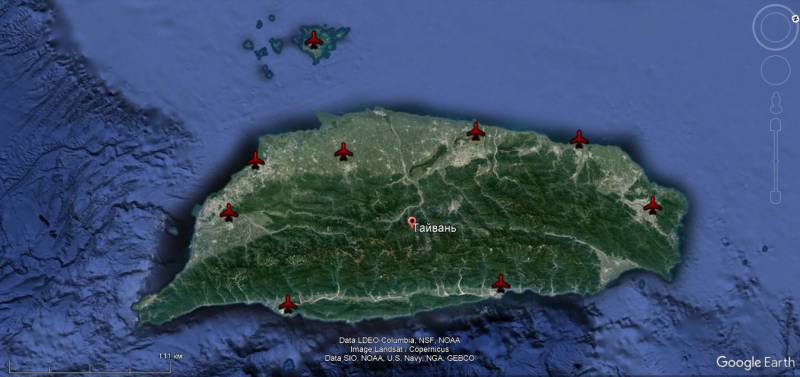
The layout of the main air bases of the Republic of China Air Force on the islands of Taiwan and Penghu
Taiwanese fighters are constantly moving around different airfields, and most of the combat aircraft are in shelters. According to expert estimates, the share of fighters in technically sound condition and capable of performing a combat mission in the Taiwan Air Force is about 70%. The average flight time for pilots is more than 100 hours per year.
F-5E/F Tiger II fighters
In the mid-1960s, the ROCAF became one of the first recipients of the F-5A/B Freedom Fighter. This fighter, manufactured by Northrop, compared to the F-100 Super Saber and F-104 Starfighter aircraft in service with the Republic of China Air Force, is much easier to operate and easy to fly. Since the Freedom Fighter had two General Electric J85-GE-13 engines with afterburner thrust of 1 kg each, flight safety was much higher than that of single-engine fighters.
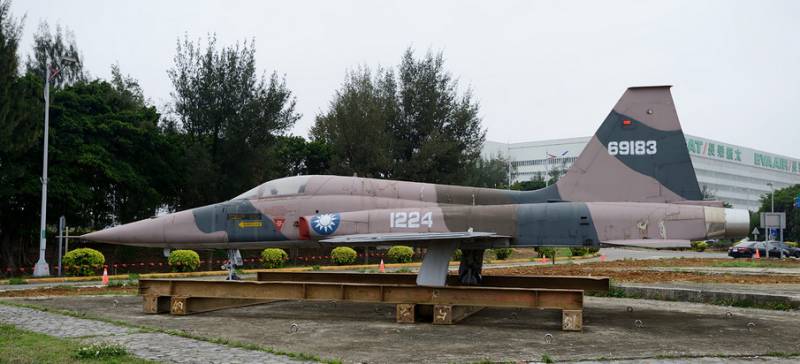
Taiwanese fighter F-5A Freedom Fighter in the museum exposition
The single-seat F-5A had a maximum takeoff weight of 9 kg. Although its top speed was only slightly above the sound barrier at 380 km/h, thanks to its relatively low wing loading, the F-1A had good maneuverability, making it a dangerous adversary in close air combat. To carry out the tasks of gaining air supremacy and interception, the armament included two 315-mm M-5A20 cannons and two AIM-39 Sidewinder melee missiles. The combat radius in the air combat configuration is 2 km. By 9, the Taiwan Air Force had 900 F-1971As and 72 F-5Bs.
In the first half of the 1970s, advanced fighters entered service with the ROCAF: single-seat F-5E and two-seat F-5F. Shortly thereafter, the Taiwanese aircraft manufacturer Aerospace Industrial Development Corporation (AIDC) received a production license and in 1975 handed over to the customer the first 24 fighters assembled from American components. A total of 1986 F-242Es and 5 F-66Fs were built in Taiwan under license until 5.
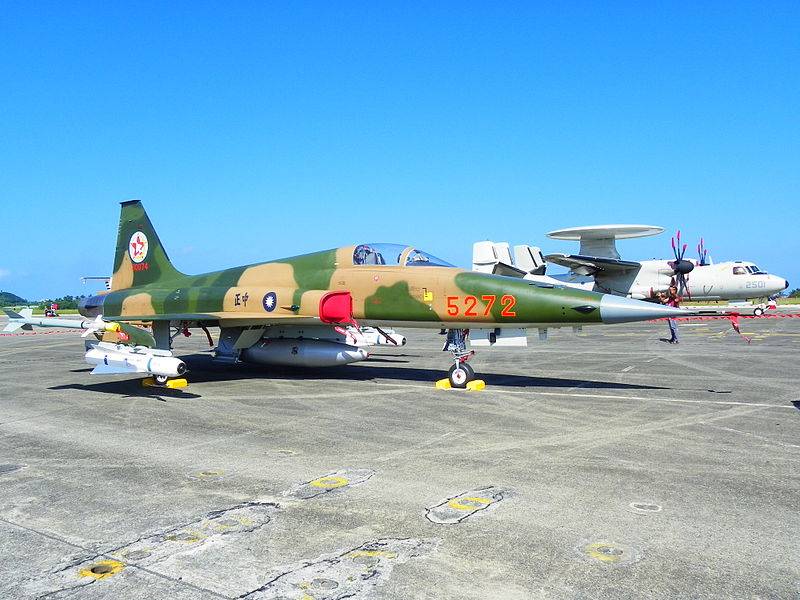
Taiwanese F-5E Tiger-II fighter
The F-5E Tiger-II fighter has a maximum takeoff weight of 11 kg. Two General Electric J561-GE-85 turbofan engines with a maximum total thrust of 21 kgf can accelerate the aircraft up to Mach 4.
The combat radius in the air combat configuration with two AIM-9 Sidewinder missiles is 1 km. In the shock version with a combat load of 400 kg - 2 km. Built-in armament: two 875 mm M-320A20 cannons with 39 rounds of ammunition per barrel. The fighter is equipped with an AN / APQ-2 radar, not bad for its time, with a range of detecting air targets up to 280 km.
In the late 1990s, AIDC Corporation tried to radically modernize the Tiger-2 by installing avionics and weapons from the F-CK-1 Ching-Kuo fighter. This variant was designated Tiger 2000/2001.
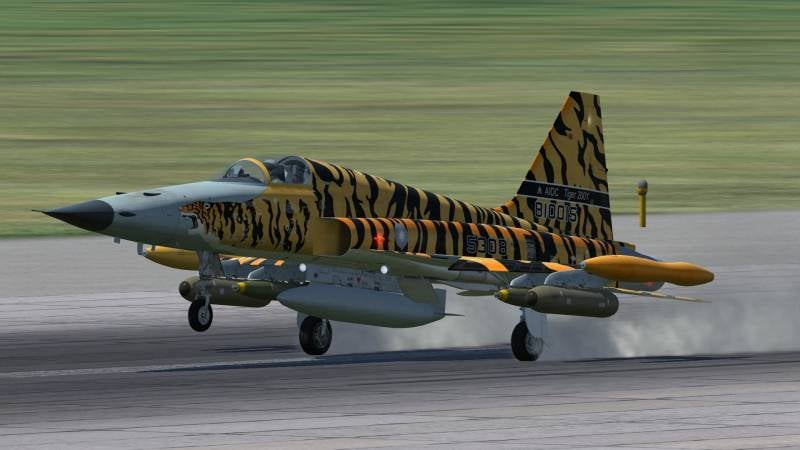
However, due to the lack of interest from the ROCAF management, the development project was not received and only one prototype was built.
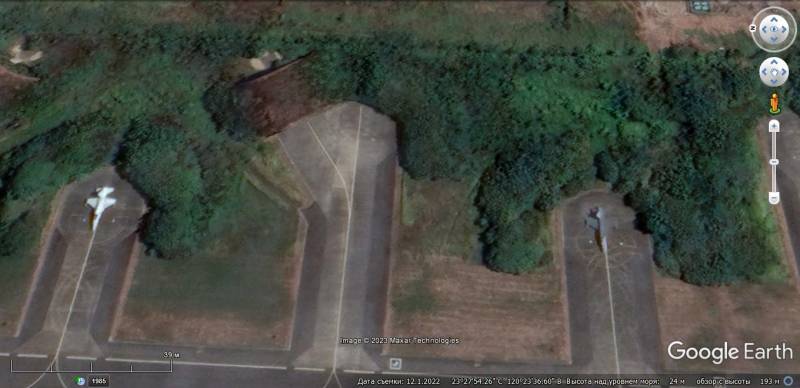
Satellite image of Google Earth: F-5E fighters at Chiayi airbase
After the 1990th generation F-4A / B Fighting Falcon, Mirage 16-2000 and F-CK-5 Ching-Kuo fighters were adopted in the second half of the 1s, the Tiger-2 aircraft were transferred to the “second line”, and they were mainly focused on the tasks of close air support for ground units and the fight against drones.
The F-5E/F is now considered obsolete, but the ROCAF still has about three dozen single and two-seat vehicles.
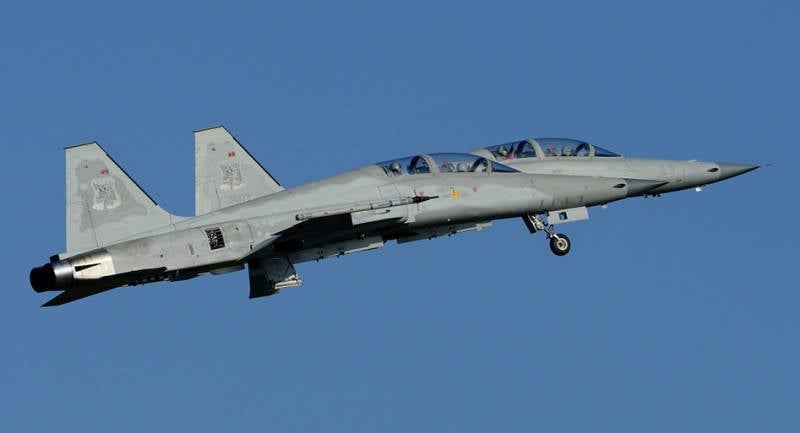
Taiwan Air Force F-5F Tiger II fighters
Single-seat and double-seat aircraft are mainly used for training purposes and represent an air enemy in exercises.
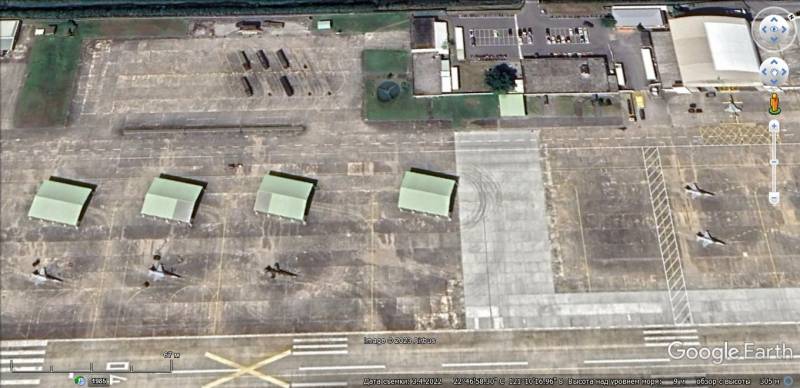
Satellite image of Google Earth: two-seat F-5F fighters at Taitung Air Base
About fifty more F-5E/Fs are in storage. According to Western authors, these aircraft can be converted into drones and used as decoys.
F-16 Fighting Falcon
In the late 1980s, the Taiwanese fighter aviation was based on the F-104A/B/G/J Starfighter and F-5E Tiger II single-seat supersonic fighters. Although at that time these aircraft were not the pinnacle of technological progress, they coped well with the tasks assigned to them.
"Starfighters" of various modifications of American, Canadian and Japanese production were operated by ROCAF until 1998. In the 1960s and 1970s, this aircraft had a high accident rate, but in the 1980s, after it was properly mastered by the flight and technical staff, and the correct tactics of use were worked out, the number of accidents and disasters decreased to an acceptable level.
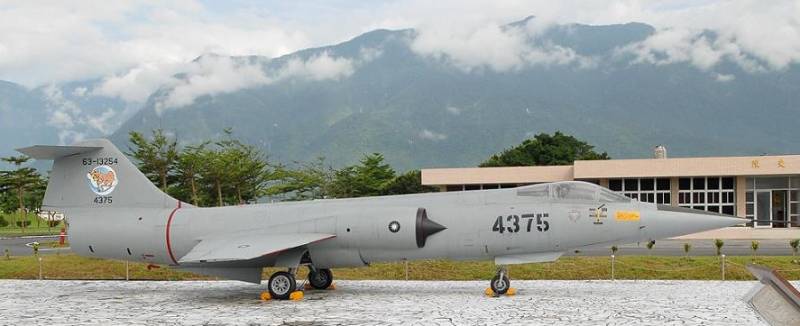
Taiwanese F-104 Starfighter
At the initial stage of operation, the F-104 was considered as a universal fighter capable of intercepting high-altitude high-speed targets, conducting close air combat, and striking ground and sea targets. However, it soon became clear that a fighter with perfect aerodynamics, but short, thin, straight wings, was contraindicated in low-altitude flights and intensive maneuvers in a "dog dump".
At the same time, the Starfighter, equipped with a radar and guided air-to-air missiles, which had a high flight speed and good acceleration characteristics, turned out to be quite good as an interceptor and could successfully withstand the PLA Air Force N-5 bombers (Chinese version of Il-28) and H-6 (Chinese version of the Tu-16).
In turn, the rather massive light Tiger-2 in close air combat had a high chance of winning in a collision with PLA Air Force J-6 (Chinese version of the MiG-19) and J-7 (Chinese version of the MiG-21) fighters.
But after the 1990th generation heavy fighters of the 4th generation of Russian production Su-27SK (and later unlicensed Chinese clones) appeared in the PRC in the early XNUMXs, the PLA Air Force received not only quantitative, but also overwhelming qualitative superiority.
In response, Taipei asked Washington to supply modern fighter jets. After the events in Tiananmen Square, US relations with mainland China cooled. In addition, after the collapse of the USSR, the main reason for “friendship” with the PRC, based on anti-Sovietism, disappeared from the Americans, and nothing prevented the transfer of modern combat aircraft to Taiwan.
In September 1992, the island of China and the United States entered into an agreement on the sale of 150 F-16A / B Fighting Falcon fighters of the Block 20 modification. The deal was valued at $ 6 billion, in total, 1997 single and 2001 double aircraft were delivered between 120 and 30. The contract also provided for the transfer of spare parts, consumables, weapons, training of flight and technical personnel.
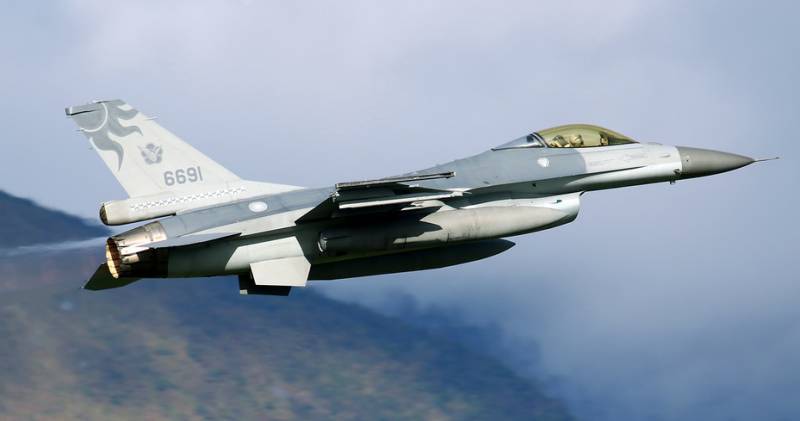
The F-16A Block 20 fighter was equipped with an AN / APG-66 (V) 3 radar with a detection range of large targets of more than 100 km. The fire control system initially allowed the use of AIM-7M Sparrow medium-range air-to-air missiles and AGM-84 Harpoon anti-ship missiles. In close combat configuration, the fighter carried 6 AIM-9L/M/P Sidewinder missiles. Built-in weapons - 20-mm gun M61A1 Vulcan (515 rounds). Combat load - 5 420 kg.
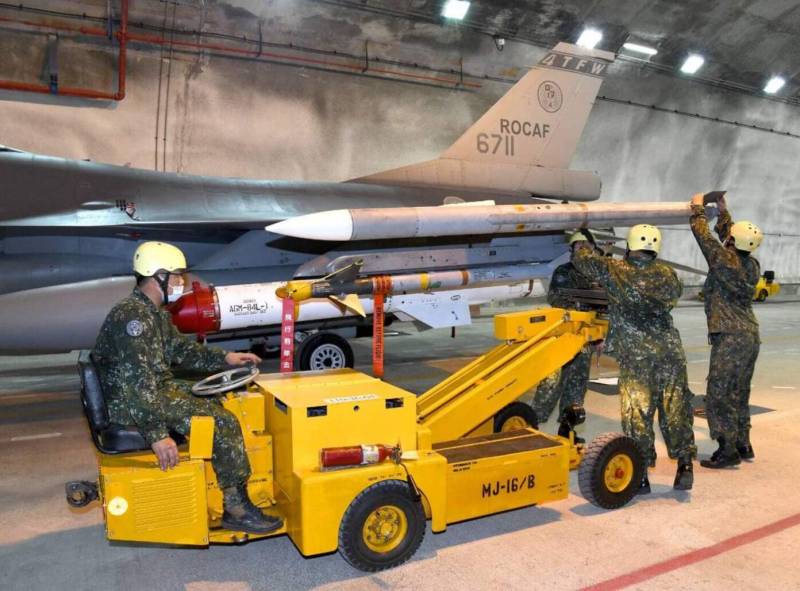
After finalizing the avionics, it became possible to suspend long-range air-to-air missiles AIM-120 AMRAAM.
The Pratt & Whitney F100-PW-200 turbofan engine with an afterburner thrust of 10 kg provided the fighter with a normal take-off weight of 810 kg with a high thrust-to-weight ratio. The maximum flight speed at high altitude is 11 km / h, near the ground - 467 km / h. Practical range - 2 km.
The development of the F-16A / B fighters allowed the ROCAF to write off the F-104 interceptors and transfer the F-5E to secondary roles. The Taiwan Air Force command considered that the F-16 is quite effective, both in the role of an interceptor and in the role of an air superiority fighter. In the past, Taiwanese fighters have repeatedly risen to meet PLA Air Force aircraft conducting reconnaissance near the borders of the republic.
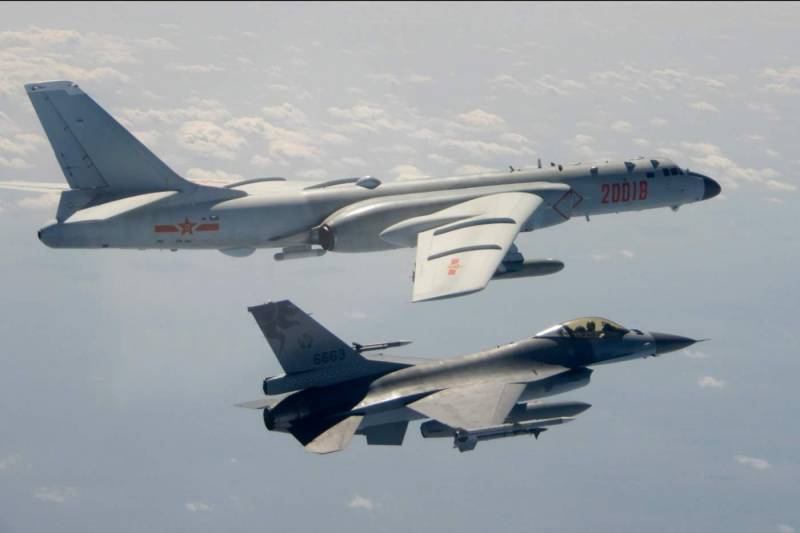
Thanks to a sufficiently powerful and perfect airborne radar, the “Fighting Falcon” is able to independently detect an air enemy at any time of the day and in difficult weather conditions at a fairly large distance, and AIM-7M Sparrow missiles with a semi-active radar guidance system made it possible to hit air targets at ranges up to 70 km . Taiwan bought 2004 AIM-200 C-120 AMRAAM long-range missiles in 5, and received another batch of 2007 missiles in 218.
The AIM-120 C-5 AMRAAM air-to-air missile with an active radar seeker range has a maximum firing range of more than 100 km and can be used in the fire-and-forget mode. The cost of one AMRAAM missile is $1,2 million.
F-16А/В fighters are in service with two tactical aviation wings. The 401st Wing, based at Hualien Air Base, has three fighter groups and one reconnaissance squadron (on RF-16A / B).
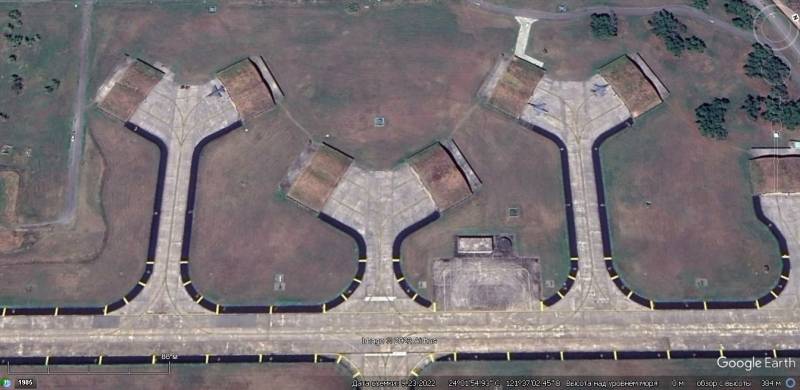
Satellite image of Google Earth: F-16 fighters at Hualien airbase
The 455th Wing has three fighter groups and a search and rescue team equipped with S-70C helicopters. The aircraft of this wing is assigned to Chiayi Air Base.
The fighter groups, which are mainly equipped with F-16А/В aircraft, also include F-5E/F aircraft, which are used for training flights, and thus the resource of more modern fighters is saved. By 2018, seven F-16A / B were lost in flight accidents.
In 2016, a contract was signed with Lockheed Martin Corporation for the modernization of the existing F-16A Вlock 20 in the F-16V Block 70. The work was to be carried out at the production facilities of the Taiwanese aircraft manufacturer AIDC, located in the city of Taichjun.
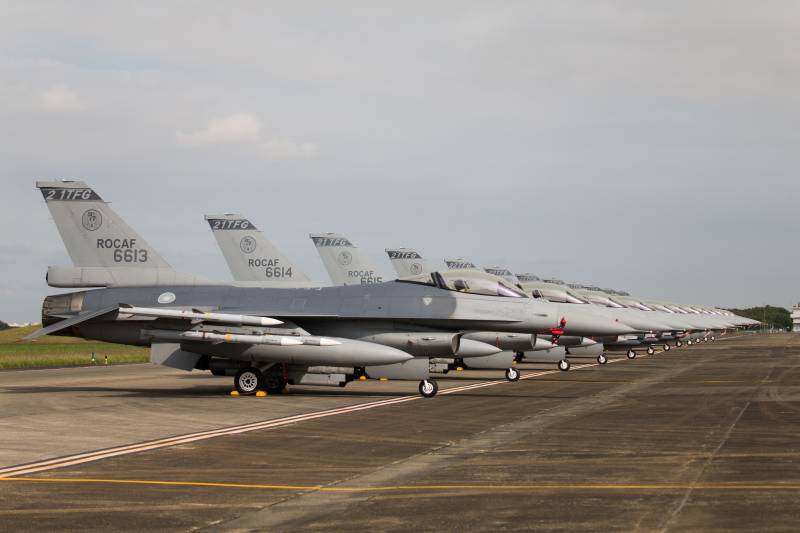
Taiwanese F-16V fighters
The F-16V (Viper) Block 70 modification is by far the most advanced in the F-16 fighter family. This variant is equipped with the new AN/APG-83 Scalable Agile Beam Radar airborne radar (range over 300 km) with AFAR, the new Viper Shield electronic warfare system, a more powerful on-board computer, an updated cockpit with large-format displays, an upgraded engine, a thermal imaging search and tracking system , improved data communication equipment, high-precision GPS navigation equipment and an automatic ground collision avoidance system.
The aircraft has the ability to integrate most types of American modern aviation weapons and install conformal fuel tanks. The resource of the new Block 70 aircraft is 12 hours, which is twice as long as that of the previous F-16 series.
Initially, it was planned to modernize all available fighters. However, during the modernization, it turned out that some of the aircraft had severe internal airframe corrosion, and it was not advisable to subject these aircraft to improvements. By December 2020, 16 F-18As were able to reach the F-16V level. Apparently, it will be possible to upgrade no more than half of the F-16A Block 20 fleet in flight condition, of which there were 2020 units as of 115.
Due to the resulting shortage of modern fighters, Taiwan ordered 66 new F-16V Block 70 fighters from Lockheed Martin, paying $ 8 billion for them. Deliveries are due to begin in 2023 and the order is expected to be completed in 2026.
In September 2022, a $1,106 billion contract was signed for the supply of additional weapons for the F-16V: 100 AIM-9X Sidewinder melee missiles, 60 AGM-84L-1 Harpoon, an unnamed number of AIM-120 C-7 AMRAAM and AGM missiles -88 HARM, as well as spare parts, consumables.
Mirage 2000-5 fighters
Simultaneously with the application for the F-16A / B Fighting Falcon Вlock 20, the Taiwanese government made a request to France regarding the possibility of selling Mirage 2000-5 fighters. The parties entered into an agreement on the supply of 60 aircraft. Of these, 48 were Mirage 2000-5EI single-seat interceptors, 12 were Mirage 2000-5DI combat trainers. Due to the fact that Taipei declared a purely defensive purpose of these aircraft, they were deprived of the possibility of aerial refueling and strike weapons.
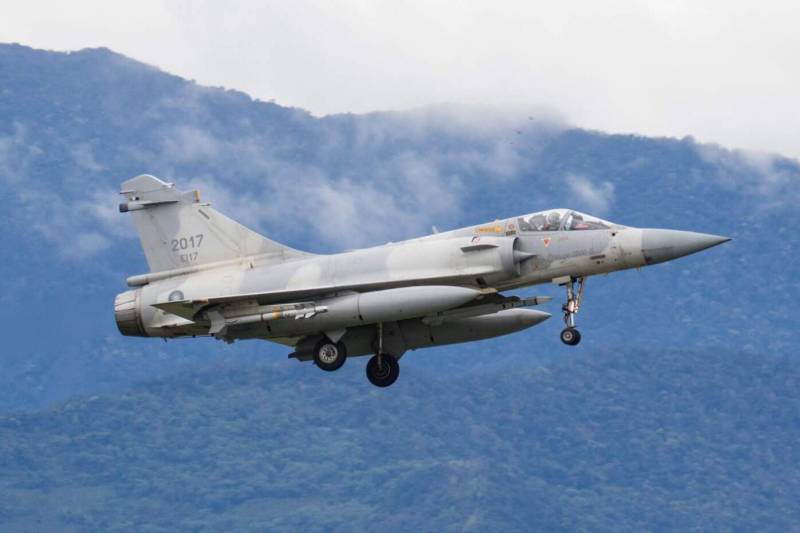
Taiwanese Mirage 2000-5EI fighter
The cost of the aircraft amounted to 2,6 billion dollars. Taiwan paid another $2,3 billion for 480 Matra R550 Magic-II short-range air-to-air missiles, 960 MBDA MICA-EM medium-range air-to-air missiles, ASTAC electronic intelligence overhead pods, ground support and diagnostic equipment, training of pilots and technicians.
Single Mirage 2000-5EI has a normal takeoff weight of 13 kg, maximum - 800 kg. The SNECMA M17-P010 turbojet engine with an afterburner thrust of 53 kN at high altitude accelerates the aircraft to 20 km/h. The maximum speed near the ground is 98,06 km / h. Practical ceiling - 2 m. Practical range - 340 km.
Built-in armament: two 30 mm DEFA 554 cannons with a total ammunition load of 250 rounds. 9 hardpoints can accommodate a load weighing up to 6 kg, including six MICA missiles and two melee missiles
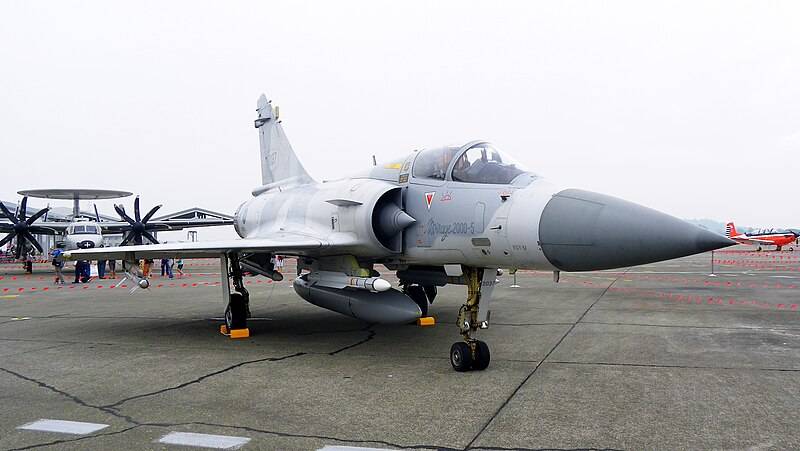
The "main caliber" are MICA-EM missiles with an active radar seeker and a firing range of up to 80 km. A rocket weighing 112 kg has a length of 3 mm and a diameter of 100 mm. The fragmentation warhead weighs 160 kg. The maximum speed is 12 M.

Model of the upgraded MICA-EM rocket, presented by the Chung-Shan Institute of Science and Technology
It is reported that the MICA-EM SDs available in Taiwan with the technical support of the French corporation MBDA were overhauled and modernized by the Chung-Shan Institute of Science and Technology. After modernization, the firing range was increased to 100 km.
The R550 Magic-II melee missile with IR seeker weighs 90 kg, length - 2 mm, diameter - 720 mm. The missile is equipped with a 157 kg warhead. Maximum flight speed - 12,7 M. Range - up to 3 km.
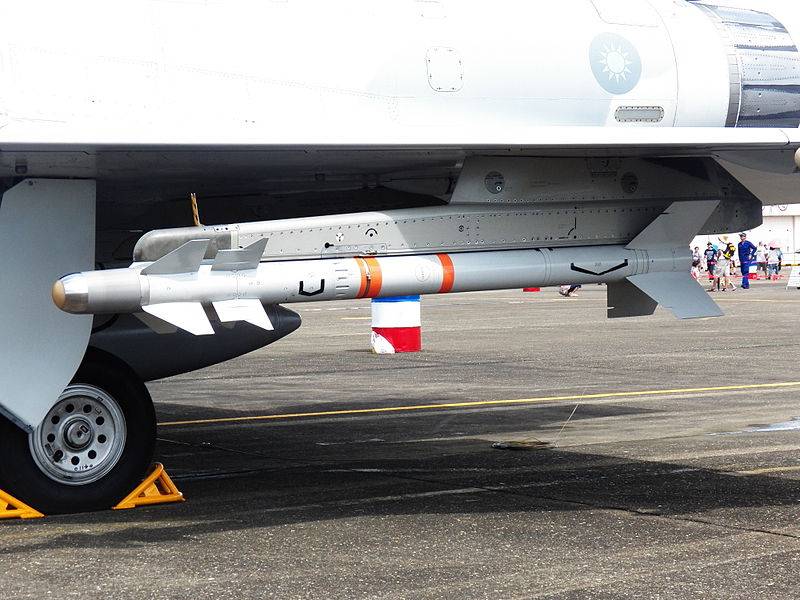
R550 Magic-II missile under the wing of a Taiwanese Mirage 2000-5EI fighter
Taiwanese Mirages are equipped with RDY radars from Thales. This station can detect an enemy fighter at a distance of 130 km, simultaneously track up to eight targets and fire at four of them. The glass cockpit instrumentation includes three multi-function displays on the instrument panel, as well as a wide-angle indicator on the windshield, combined with an indicator below it, located at the level of the pilot's eyes. The Mirage 2000-5EI fighter received an integrated electronic warfare system ICMS Mk 2.
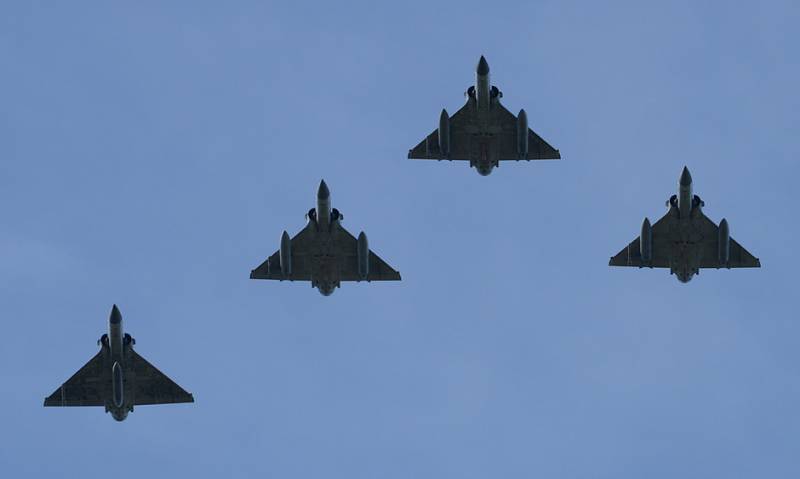
The Mirages entered service with the 499th tactical air wing, headquartered at the Hsinchu airbase, which includes three air groups.
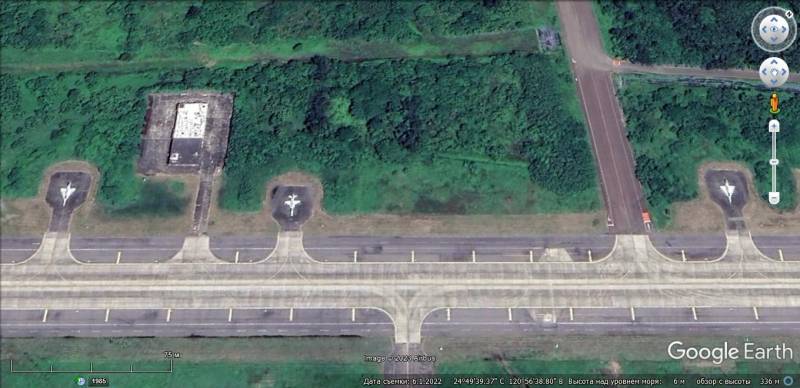
Satellite image of Google Earth: Mirage 2000-5 and F-5E fighters at Hsinchu Air Base
About 10 years ago, the Taiwan Air Force encountered difficulties in operating French-made fighters, which negatively affected combat readiness and required large additional investments. The humid maritime climate had a detrimental effect on the avionics of fighters, and cracks in the turbine blades were found in the engines. However, through the joint efforts of the Taiwanese corporation AIDC and the French Dassault Aviation, most of the aircraft were successfully repaired. As of 2021, there were 46 single-seat Mirage 2000-5EIs and 9 two-seat Mirage 2000-5DIs in service.
F-CK-1 Ching-Kuo fighters
After diplomatic relations were established between Washington and Beijing, the level of US support for the island Republic of China decreased. Against this background, the government in Taipei had reason to fear that Taiwan would be denied supplies of modern American weapons.
And when the administration of Ronald Reagan in 1982, wanting to get a strong ally in the person of the PRC, imposed an arms embargo on Taiwan, the AIDC corporation launched the IDF program (Indigenous Defensive Fighter - national defensive fighter), which envisaged the creation of a light all-weather fighter, capable of also striking ground targets, with low life cycle cost, easy maintenance and high reliability.
Although the Americans formally adhered to the arms embargo, this did not prevent American aviation corporations from assisting in the creation of the Taiwanese fighter. As a result, the design of the F-CK-1 Ching-Kuo fighter, created by AIDC, clearly shows the features of the F-16 Fighting Falcon.
It is known that General Dynamics Corporation received more than $ 50 million for the specifications and drawings of the Fighting Falcon. Taiwanese experts did not blindly copy the American fighter, but creatively redesigned it to fit their requirements.
The size of the "Jing-Guo" has become somewhat smaller than the F-16. The aircraft received a high-mounted, moderately swept wing with increased root influx, with improved flight characteristics at high angles of attack. The single-keel vertical tail and all-moving differential stabilizer are similar to those used on the American "ancestor", but the fuselage has undergone major changes associated with the installation of two engines and oval-shaped side air intakes similar to those used on the F-18.
The F-CK-1 Ching-Kuo fighters are equipped with Honeywell / ITEC F125-GA-100 engines with a nominal thrust of 2 kg (with afterburner 740 kg). This turbofan was created jointly by the Taiwanese company ITEC and the American Garrett. Maximum takeoff weight - 4 300 kg. The maximum speed at high altitude is 12 km/h. Practical range - 247 km. Practical ceiling - 2 m.
The on-board electronic equipment of the Jing-Guo fighter was created with the support of American companies. So, the GD-53 radar is based on the design of the AN / APG-67 radar, created by General Electric for the F-20 Tigershark light fighter that did not go into the series. The design of the GD-53 radar also contains elements of the AN / APG-66 radar used on the F-16A. According to available information, the Taiwanese multi-mode pulse-Doppler radar is capable of detecting the H-6 bomber at a distance of 150 km. The detection range of the J-7 fighter is 70 km. It is possible to simultaneously track 10 targets and fire two of them.
Other American-designed equipment is used similarly: EDSU with triple redundancy, radar exposure warning equipment, jamming, navigation systems, etc.
The first prototype of the F-CK-1 Ching-Kuo, painted in red, white and blue, flew on May 28, 1989.
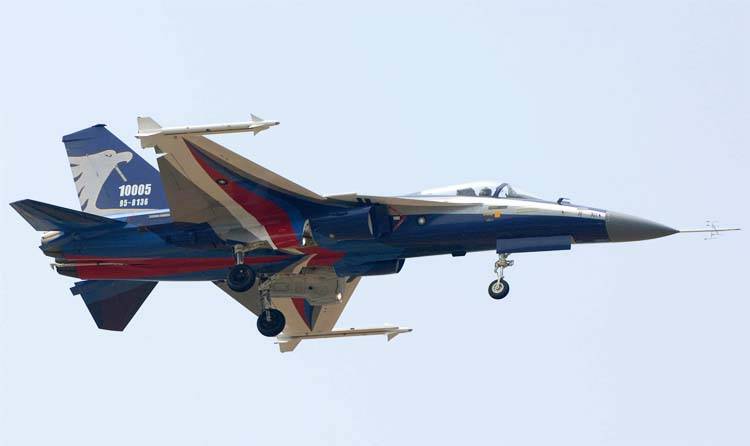
Serial assembly was carried out from 1994 to 2001. Initially, it was planned to build 256 aircraft, but after it was possible to agree with the United States on the supply of F-16A / B fighters, the order, taking into account experimental aircraft, was reduced to 130 units, of which 28 are two-seat combat trainers. A single-seat fighter has the designation F-CK-1A, and a two-seat fighter has the designation F-CK-1B.
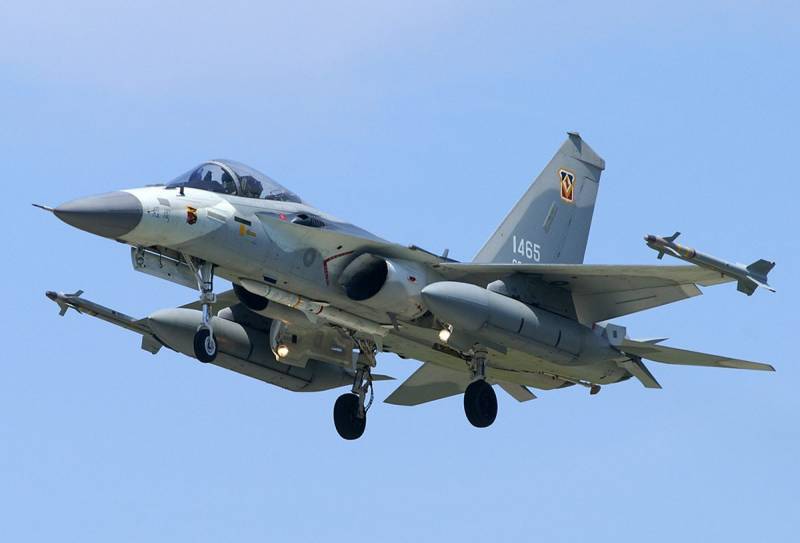
F-CK-1А Ching-Kuo fighter with Sky Sword I and Sky Sword II air-to-air missiles
At the initial stage of work on the Jing-Guo fighter, it was not clear whether the United States would continue to supply Taiwan with air-to-air missiles. In this regard, the ROCAF leadership initiated the development of its own missiles with thermal and radar guidance systems designed for close combat and long-range interception.
The TGS missile, based on the AIM-9L Sidewinder, was designated Sky Sword I. The long-range missile is known as Sky Sword II. These missiles are used in the same way as anti-aircraft missiles and are discussed in detail here.
In addition to Taiwanese-made air combat missiles, nine hardpoints can accommodate: UR AIM-9L / P, 227-kg or 907-kg free-fall bombs, GBU-12A laser-guided bombs, NAR units, UR AGM-65 Maverick and outboard fuel tanks. A 6-barreled 20-mm M61A2 Vulcan cannon is installed on the port side.
The total mass of the combat load is up to 3 kg. At the design stage, it was assumed that the aircraft would be able to carry a free-falling nuclear bomb weighing up to 900 kg. But under US pressure, Taiwan's nuclear weapons program was curtailed.
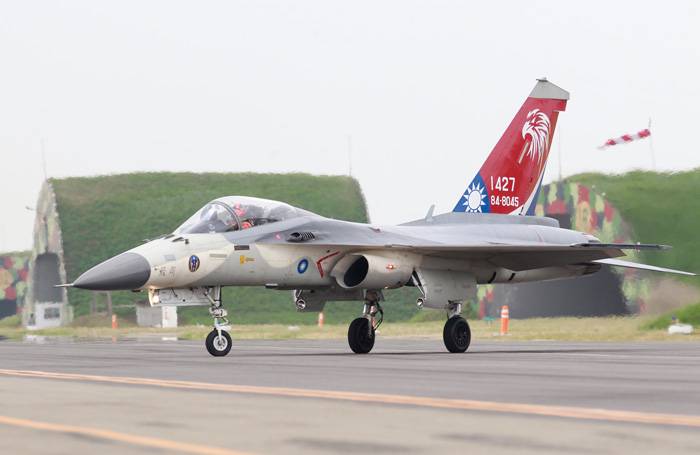
In 2007, the modernization of the F-CK-1A / B Ching-Kuo fighters to the level of F-CK-1C / D Hsiung Ying (“Brave Hawk”) began. During the modernization program with a total cost of more than $ 500 million, combined with a major overhaul, the aircraft received a new control system with its own software, an integrated electronic warfare station with automatic response to threats, and an improved radar. Due to the increase in fuel capacity by 771 liters, the chassis was reinforced. The number of long-range missiles on board has been increased from 2 to 4.
As of 2021, 103 single-seat F-CK-1Cs and 26 two-seat F-CK-1Ds were operated by the ROCAF.
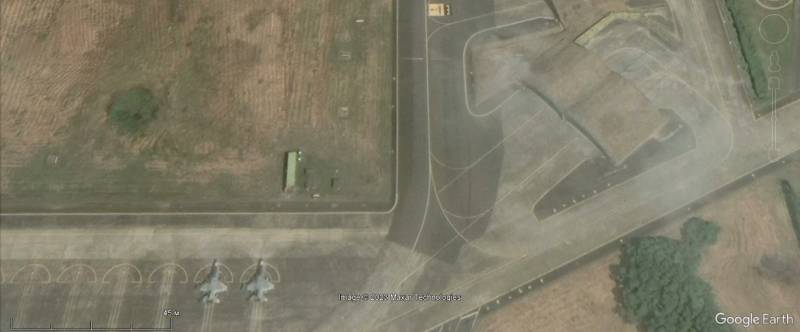
Satellite image of Google Earth: F-CK-1С fighters at Tainan Air Base
These aircraft are armed with the 427th tactical air wing, headquartered at Ching Chuan Kann airbase, which includes two fighter air groups, and the 443rd tactical air wing, consisting of three air groups assigned to the Tainan airbase.
Information